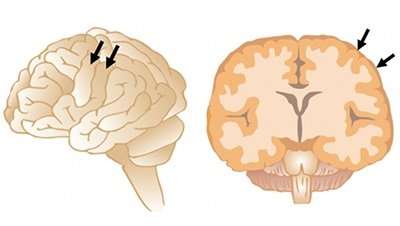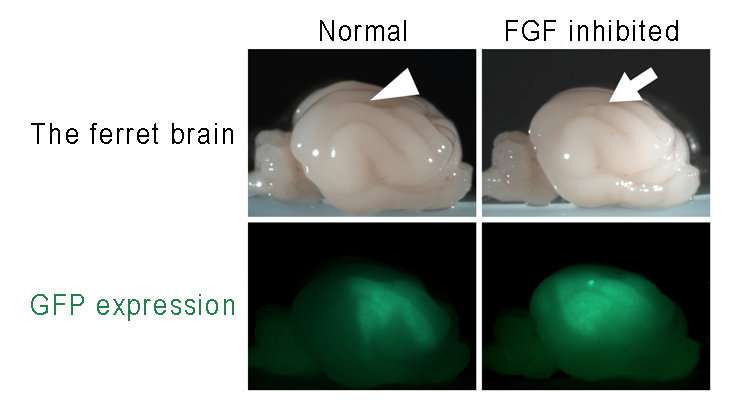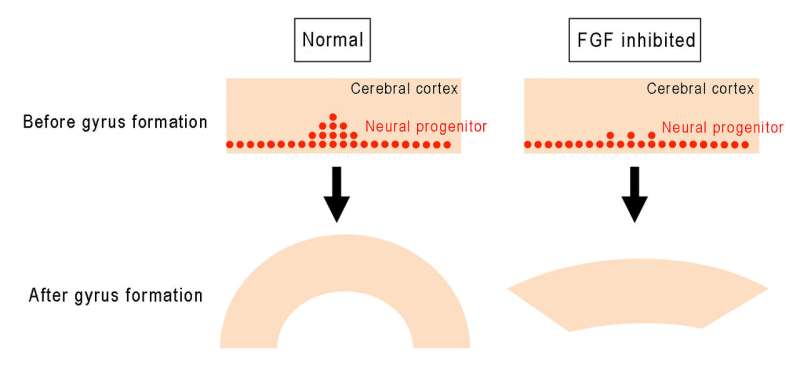Fold formation of the cerebral cortex requires FGF signaling in the mammalian brain

The cerebral cortex is particularly important in higher brain functions. The cerebral cortex of higher animals, including humans, has many folds, called the gyrus (Figure 1). Because of the gyrus, higher animals have a large number of neurons, and thus great development of brain functions. On the other hand, the mouse, a widely used model animal, has a brain without gyri. This has made it very difficult to do research on the gyrus using the mouse as a model animal; therefore, research on the gyrus has been much retarded.
A research group at Kanazawa University, Japan, has been using the ferret, a higher mammal, that has a brain more similar to the human brain than that of the mouse. The ferret brain is known to have gyri, but researchers lack techniques for ferret brain studies. The research group developed a technique for the ferret brain, which allows analysis of ferrets at the genome level, and reported the results in 2012 and 2013. By using this technique, they succeeded in developing a ferret disease model that shows impairment in gyrus formation. In the present study, using their technique, they have identified a signaling pathway that plays important roles in gyrus formation in the cerebral cortex of higher mammals.

The Kanazawa University group has investigated mechanisms involved in gyrus formation during early ferret cerebral cortex development, and identified for the first time that FGF signaling) is important in gyrus formation.
Major findings of the study include:
- Expression of FGF receptors is augmented where gyrus formation is about to take place. Examination of tissue sections of various cerebral cortex regions that express FGF receptors indicated that regions destined to form gyri expressed more FGF receptors than other regions. This result suggests the possibility that FGF receptors mediate gyrus formation.
- When FGF signaling is inhibited, gyrus formation is impaired. In order to verify the above possibility, FGF signaling in the ferret brain was inhibited by using the technique previously developed by the research group. As expected, gyrus formation was impaired (Figure 2). This result indicates that FGF signaling is important for gyrus formation.
- Inhibition of FGF signaling reduces neural progenitors. They investigated what would happen in the cerebral cortex where gyrus formation was impaired due to the inhibition of FGF signaling, and found that neural progenitors that produce neurons in the cerebral cortex were much reduced in number (Figure 3).
- Inhibition of FGF signaling reduces the number of neurons in the cerebral cortex. Since the reduction was observed in the number of neural progenitors that produce neurons in the cerebral cortex, they next investigated the number of neurons and found that in the superficial layer of the cerebral cortex where FGF signaling was inhibited was particularly reduced in comparison to other layers.
In summary, the study concluded that FGF signaling augments the number of neuronal progenitors and neurons in regions destined to become gyri, and, as a result, gyri, folds of the cerebral cortex, are formed (Figure 3).

In the present study, the authors uncovered an important mechanism of gyrus formation in the cerebral cortex by using their unique research technique developed for the ferret. In the past, there have been few studies on the mechanisms of gyrus formation with animal models. As mentioned above, the research group succeeded in 2015 in developing a ferret disease model that shows impairment in the gyrus.
It is expected that further studies along these lines should contribute to research on brain evolution, up to that of the human, which has been difficult in the past, and to the investigation of causes and treatment of various diseases of the brain and the nervous system.
More information: Naoyuki Matsumoto et al, Gyrification of the cerebral cortex requires FGF signaling in the mammalian brain, eLife (2017). DOI: 10.7554/eLife.29285


















